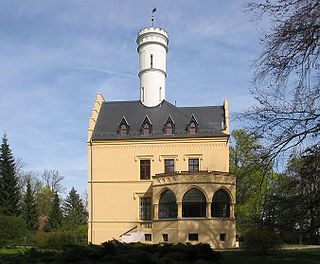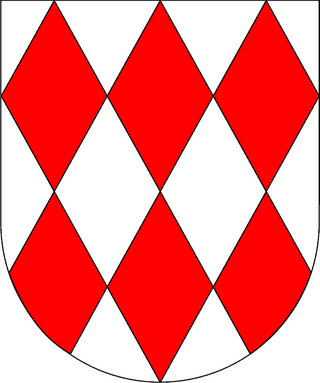
Merseburg is a town in central Germany in southern Saxony-Anhalt, situated on the river Saale, and approximately 14 km south of Halle (Saale) and 30 km west of Leipzig. It is the capital of the Saalekreis district. It had a diocese founded by Archbishop Adalbert of Magdeburg. The University of Merseburg is located within the town. Merseburg has around 35,000 inhabitants.

Saxony-Anhalt is a state of Germany, bordering the states of Brandenburg, Saxony, Thuringia and Lower Saxony. It covers an area of 20,451.7 square kilometres (7,896.4 sq mi) and has a population of 2.17 million inhabitants, making it the 8th-largest state in Germany by area and the 11th-largest by population. Its capital and largest city is Magdeburg.

Thale is a town in the Harz district in Saxony-Anhalt in central Germany. Located at the steep northeastern rim of the Harz mountain range, it is known for the scenic Bode Gorge stretching above the town centre.

Hettstedt is a town in Mansfeld-Südharz district, Saxony-Anhalt, Germany, on the Wipper. It consists of Hettstedt proper and the Ortschaften Ritterode and Walbeck. The former municipalities Ritterode and Walbeck were absorbed into Hettstedt in September 2010.

Gerbstedt is a small town in Saxony-Anhalt, district Mansfeld-Südharz. It was traditionally dominated by copper mining, presently agriculture is dominant.

Gommern is a town in the Jerichower Land district, in Saxony-Anhalt, Germany. It is situated approximately 15 km (9 mi) southeast of Magdeburg. On January 1, 2005, the municipalities Dannigkow, Dornburg, Karith, Ladeburg, Leitzkau, Menz, Nedlitz, Vehlitz and Wahlitz have been incorporated into Gommern. On January 1, 2008, Prödel was incorporated, and on January 1, 2009, Lübs was incorporated.

Elbe-Parey is a municipality in the Jerichower Land district, in Saxony-Anhalt, Germany. It is situated on the Elbe-Havel Canal, approx. 40 km northeast of Magdeburg. It was established in September 2001 by the merger of the seven former municipalities Bergzow, Derben, Ferchland, Güsen, Hohenseeden, Parey and Zerben.

Möckern is a town in the Jerichower Land district, in Saxony-Anhalt, Germany. It is situated east of Magdeburg. The Battle of Möckern took place south of the town in 1813.

Mansfeld, sometimes also unofficially Mansfeld-Lutherstadt, is a town in the district of Mansfeld-Südharz, in Saxony-Anhalt, Germany.

Allstedt is a town in the district of Mansfeld-Südharz, in Saxony-Anhalt, Germany. It is situated approximatively 10 km southeast of Sangerhausen.

Kropstädt is a village and a former municipality in Wittenberg district in Saxony-Anhalt, Germany. Since 1 January 2010, it is part of the town Wittenberg.

Erxleben is a municipality in the Börde district in Saxony-Anhalt, Germany. On 31 December 2009 it absorbed the former municipality Bregenstedt, followed by the former municipalities Bartensleben, Hakenstedt and Uhrsleben on 1 January 2010. The municipality consists of the Ortsteile Bregenstedt, Erxleben, Groß Bartensleben, Groppendorf, Hakenstedt, Klein Bartensleben and Uhrsleben.

Am Großen Bruch is a municipality in the Börde district in Saxony-Anhalt, Germany. It is part of the Verbandsgemeinde Westliche Börde. The municipality was created on 1 July 2004 by the merger of the former municipalities Gunsleben, Hamersleben and Neuwegersleben. On 1 January 2010 it absorbed the former municipality Wulferstedt.

Wethau is a municipality in the Burgenlandkreis district, in Saxony-Anhalt, Germany. Since 1 January 2010 it has included the former municipality of Gieckau.

The House of Mansfeld was a princely German house, which took its name from the town of Mansfeld in the present-day state of Saxony-Anhalt. Mansfelds were archbishops, generals, supporters as well as opponents of Martin Luther, and Habsburg administrators.

Seegebiet Mansfelder Land is a municipality in the Mansfeld-Südharz district, Saxony-Anhalt, Germany. It was formed on 1 January 2010 by the merger of the former municipalities Amsdorf, Aseleben, Erdeborn, Hornburg, Lüttchendorf, Neehausen, Röblingen am See, Seeburg, Stedten and Wansleben am See. On 1 September 2010 Dederstedt was absorbed into the municipality. These 11 former municipalities are now Ortschaften or municipal divisions of Seegebiet Mansfelder Land.

Arnstein is a town in the Mansfeld-Südharz district, Saxony-Anhalt, Germany. It was formed on 1 January 2010 by the voluntary merger of twelve former municipalities. Its mayor is Frank Sehnert.

Südharz is a municipality in the Mansfeld-Südharz district, Saxony-Anhalt, Germany. It was formed on 1 January 2010 by the merger of the former municipalities Bennungen, Breitenstein, Breitungen, Dietersdorf, Drebsdorf, Hainrode, Hayn, Kleinleinungen, Questenberg, Roßla, Rottleberode, Schwenda and Uftrungen. Wickerode and the town Stolberg were added in September 2010. These 15 former municipalities are now Ortschaften or municipal divisions of Südharz.

Oranienbaum-Wörlitz is a town in the district of Wittenberg, in Saxony-Anhalt, Germany. It was formed on 1 January 2011 by the merger of the former towns Oranienbaum and Wörlitz and the former municipalities Brandhorst, Gohrau, Griesen, Horstdorf, Kakau, Rehsen, Riesigk and Vockerode. These former municipalities are now Ortschaften of the town Oranienbaum-Wörlitz.



























